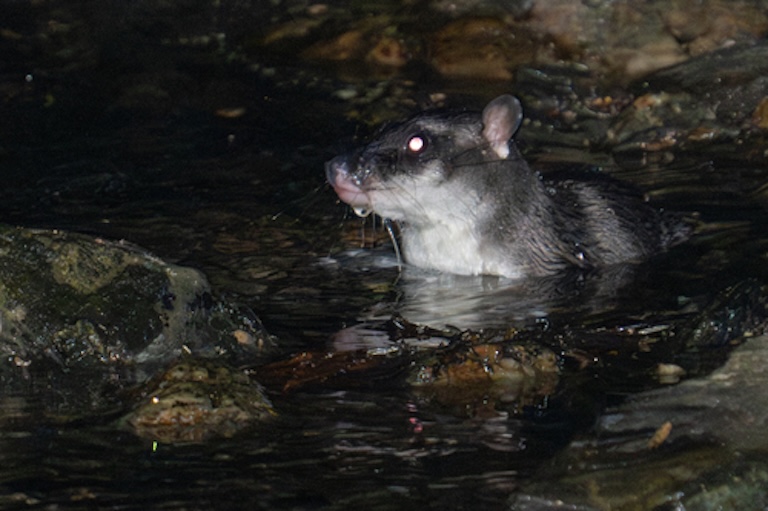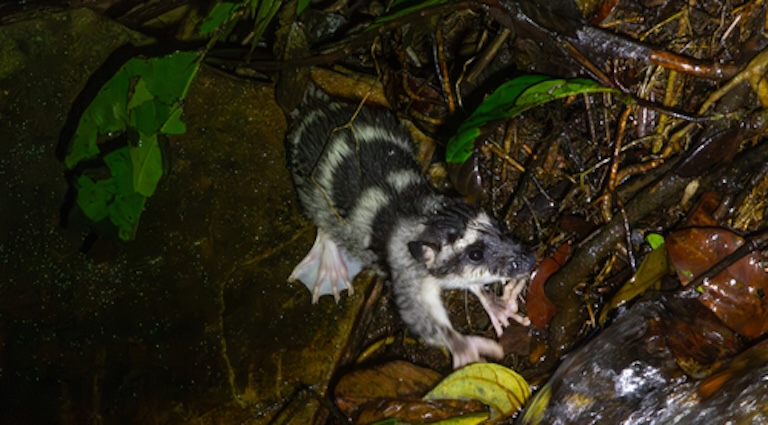Yapok Profile
Marsupials are best known from the hoppity, hare-like boxers and intoxicated eucalyptus munchers in Australia.
And that is indeed where most of them are found, but they were once the dominant group of mammals on Earth, and while they’ve been usurped almost everywhere else, a handful hold the fort in the Americas, including the well-known “Possum”, which actually isn’t a possum but an opossum, and the only realistic case of the South rising again in North America.
This one, a South American native, is unimpressed by placental dominance and seeks to show them all how the old school does it.

Yapok Facts Overview
| Habitat: | Semi-aquatic or aquatic; freshwater systems, near-shore lakes |
| Location: | Central America, Northwestern and Eastern South America. |
| Lifespan: | 1-3 years |
| Size: | 27–32.5 cm (10.6–12.8 in) long with a 36–40 cm (14–16 in) long tail |
| Weight: | Around 700g |
| Colour: | Marbled grey and black fur with a black face |
| Diet: | Varied, omnivorous: Mostly arthropods, also fish, fruit, algae |
| Predators: | Raptors, but mostly unknown. Likely predatory cats. |
| Top Speed: | Unknown |
| No. of Species: | 1 |
| Conservation Status: | Least Concern |
Yapoks are unusual marsupials who simply refused to be replaced.
They occupy a niche on the riverside that in every other location has been filled by placentals. And they do it with a combination of fun and strange adaptations, including the marsupial equivalent of a speedo to protect the junk.
They’re slowly declining (aren’t we all?) but all in all, the species isn’t in any imminent danger.
Interesting Yapok Facts
1. They’re opossums!
Marsupials are so cool. They’re a very early mammalian prototype, and for a very long time, they were the dominant group of mammals on the planet. In most places, they’ve been pushed out by the native placental mammals (like us, for example) but in Australia, they maintain this dominance. And in South America, where they originate, there are still several survivors, too.
Until very recently, marsupials were the dominant mammals on South America, as well, but an influx of placentals from the North pushed them aside in what is known as the Great American Biotic Interchange, or GABI, during which the vast majority of dominant vertebrates in South America got absolutely obliterated by far more dangerous groups of animals.
Only a few brought the fight to them and managed to advance from South to North, and among these were the Didelphidae family of marsupials, who made it even up as far as Canada! And to this day, opossums, or “Possums” as they’re often erroneously called, thrive on the continent, and their order, Didelphimorphia, is the most diverse of any marsupial order, with more than 350 species in it.
The Yapok, or the “Water opossum” is one member of this same family, but one that stayed put in South America, and occupied a niche that no other marsupial has: they’re semiaquatic.
Incidentally, possums are real, but they’re a totally different order of marsupial (the one with kangaroos and koalas), found only in Australia and New Guinea.
2. They burrow
Water opossums are found on the banks of freshwater systems, much like the water voles in Europe, and many other placental semiaquatic placentals all over the world.
They spend a lot of time in the water, but they also dig into the banks, making elaborate burrows for safety. The entrances are secluded, and descend about 45 degrees downwards from just above the water line, terminating in a comfortable nesting area. 1

3. They grow fast!
These burrows will be the home of the juvenile water opossums until they’re ready to venture out alone, which, as it happens, isn’t very long.
In December, the mother will mate, and less than two weeks later the babies are born in the nest. By around three weeks, they’ve grown fur, and around at month and a half old, they’re opening their eyes and getting out of the pouch.
By 7 weeks old, they stop suckling entuirely and by 2 months they’re already independent.
This species doesn’t live all that long, usually somewhere between one and three years, but they are pretty special in what they can do in that time.
4. They’re multipurpose marsupials
Yapoks are well adapted for a life of variety. Their webbed back feet allow them excellent swimming capabilities, but they also retain the dexterity of an unwebbed, five-fingered “hand” on the end of the front two limbs. This allows it to climb and manipulate its world with its forefeet and glide effortlessly through the water with its hind legs.
Its long, slender tail also helps with propulsion, and its dense, short fur helps with waterproofing and insulation.
And for protection from flooding, look no further than pouch sphincters. 2
5. They have pouch sphincters
The Yapok is one of the very rare animals whose males and females both have a pouch. Being watery creatures, there’s always a risk of the pouch filling with water, so in the yapok, this opening faces backwards already, but an added layer of protection comes from a ring of muscle around the opening that allows the pouch to close up like a seal’s nostril when submerged.3
For the females, the purpose of this is obvious, and for the male, this pouch is to protect the genitals from becoming entangled in weeds, or adding drag while swimming, which is, coincidentally, a common issue among animal bloggers, too.

6. They’re pest control
The majority of the Yapok’s food comes from aquatic insects and larvae. Many of these arthropods are potential pests, so the Yapok’s presence has a great dampening effect on this potential.
Their dens are also useful, as abandoned ones can be repurposed by other riverside residents, and are often borrowed by other yapoks too.
7. They’re doing ok
Overall, this species is in decline, but their numbers and range keep them up in the category of Least Concern from a conservation standpoint.
Deforestation, water pollution, and all the usual human-caused problems are the biggest threats to this species, and it’s important to point to the lack of specific knowledge about this animal as having the potential for overestimating the situation, but given what is known, the general consensus is that it isn’t in any immediate danger as a species.
Yapok Fact-File Summary
Scientific Classification
| Kingdom: | Animalia |
| Phylum: | Chordata |
| Class: | Mammalia |
| Order: | Didelphimorphia |
| Family: | Didelphidae |
| Genus: | Chironectes |
| Species Name: | minimus |
Fact Sources & References
- McHugh et al., “Chironectes minimus water opossum”, Animal Diversity Web.
- “Yapok (Water Opossum)”, Unsung Animals Wiki.
- (2015), “Water Opossum”, IUCN Red List.
